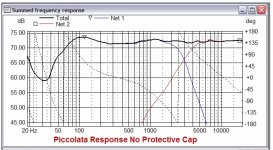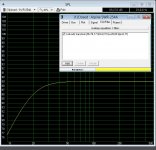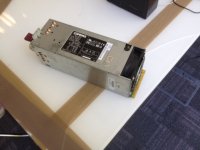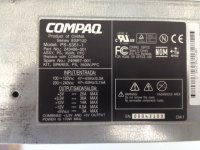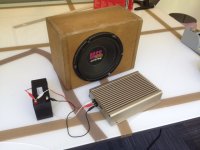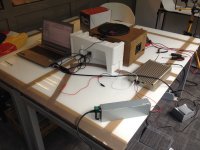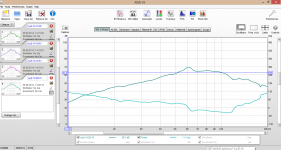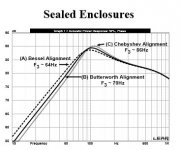Hello,
I am using small DIY 2-way ported bookshelf speakers with an F3 of around 56Hz (freq. respons in attach) and my system is intended for
music only. I am now thinking about building small subwoofer , preferably sealed and on a budget.
Something like this seems doable, because Peerless SLS 10" 830668 is cheap :
Pluto + subwoofer
Can I just add subwoofer to my main speakers with 80 Hz low pass and call it a day, or the integration is much more complex ( in the sense that I should high pass my main speakers, blocking vents on them etc.)?
Regards
Marko
I am using small DIY 2-way ported bookshelf speakers with an F3 of around 56Hz (freq. respons in attach) and my system is intended for
music only. I am now thinking about building small subwoofer , preferably sealed and on a budget.
Something like this seems doable, because Peerless SLS 10" 830668 is cheap :
Pluto + subwoofer
Can I just add subwoofer to my main speakers with 80 Hz low pass and call it a day, or the integration is much more complex ( in the sense that I should high pass my main speakers, blocking vents on them etc.)?
Regards
Marko
Attachments
Marko,Can I just add subwoofer to my main speakers with 80 Hz low pass and call it a day, or the integration is much more complex ( in the sense that I should high pass my main speakers, blocking vents on them etc.)?
You can add a subwoofer with a 80 Hz low pass and call it a day, or get better sound with proper integration. A HP on the top speakers can clean up the sound considerably at higher volume levels, if you don't listen at levels where their linear excursion is exceeded, you may not notice much difference.
Marko,
You can add a subwoofer with a 80 Hz low pass and call it a day, or get better sound with proper integration. A HP on the top speakers can clean up the sound considerably at higher volume levels, if you don't listen at levels where their linear excursion is exceeded, you may not notice much difference.
Hello weltersys,
the reason I asked if I can get away without highpass for the mains is because my cheap plan was to use a car amplifier which is sitting in the closet doing nothing and has only low pass for the subwoofer. If I want to highpass the mains that would mean buying a plate amplifier with highpass passtrough or something like miniDSP, right?
But, reading between the lines, use of a subwoofer without touching the mains would still be beneficial though not to full potential?
Regards
Marko
The Pluto sub has a rather complex active filter for it to work properly.
Highpassing the mains is very simple compared to the filter of the sub. And while your at it remove the bump in the 80-200Hz. The ASP of the Pluto subs has a highpass for the mains in it.
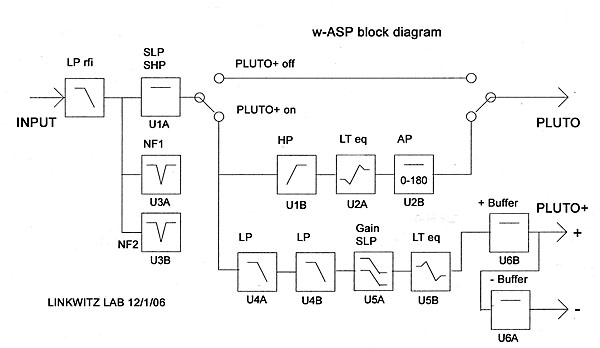
These subs go very low (f-3dB=8Hz) and are very high quality. I have 4 of them.
Highpassing the mains is very simple compared to the filter of the sub. And while your at it remove the bump in the 80-200Hz. The ASP of the Pluto subs has a highpass for the mains in it.

These subs go very low (f-3dB=8Hz) and are very high quality. I have 4 of them.
Chris and Tatoo,
thanks for your input, I have a lot to absorb here.
ASP boards are above my budget at the moment together with the cost of new Peerless driver.
Will this do, 88dB at 30Hz, unless I got it completely wrong:
Linkwitz-Riley Electronic Crossover
+
Alpine SWR-254A (gathering dust as well)
I tried to simulate in WinISD, can someone check my work. First time user and the Qts of the driver in PDF is suspicous so I used 0,30 instead of 0.030
In zip file is a WinISD .wdr file for my driver.
Thanks
Marko
thanks for your input, I have a lot to absorb here.
ASP boards are above my budget at the moment together with the cost of new Peerless driver.
Will this do, 88dB at 30Hz, unless I got it completely wrong:
Linkwitz-Riley Electronic Crossover
+
Alpine SWR-254A (gathering dust as well)
I tried to simulate in WinISD, can someone check my work. First time user and the Qts of the driver in PDF is suspicous so I used 0,30 instead of 0.030
In zip file is a WinISD .wdr file for my driver.
Thanks
Marko
Attachments
You can put the Alpine speaker in a small sealed box.
Measure its frequency response with a measuring mic up close, a few cm will do.
Then use the Linkwitz Transform Subwoofer Equaliser and adjust the frequency response to taste. highpass f-3dB of 40-20Hz is good enough for most people.
Now you need to lowpass the sub with the low section of the Linkwitz-Riley Electronic Crossover at say 80Hz. You can highpass the main speakers at the 80Hz and as an option try to remove the 80-200Hz bump.
Put the sub in a corner of the room closest to the main speakers and measure the total response of the system. Measure all across the listening position and avarage the measurements. Start adding broadband absorption/basstraps to flatten the frequency response. The more broadband absorption/basstraps the flatter the frequency response will be, and the better your system will sound.
A measuring mic doesn't need to cost much, I use the Mitey Mic
Measuring software is free: REW - Room EQ Wizard Room Acoustics Software
And info on basstraps/acoustics is here: Ethan Winer: The Audio Expert - MusicPlayer Forums
Measure its frequency response with a measuring mic up close, a few cm will do.
Then use the Linkwitz Transform Subwoofer Equaliser and adjust the frequency response to taste. highpass f-3dB of 40-20Hz is good enough for most people.
Now you need to lowpass the sub with the low section of the Linkwitz-Riley Electronic Crossover at say 80Hz. You can highpass the main speakers at the 80Hz and as an option try to remove the 80-200Hz bump.
Put the sub in a corner of the room closest to the main speakers and measure the total response of the system. Measure all across the listening position and avarage the measurements. Start adding broadband absorption/basstraps to flatten the frequency response. The more broadband absorption/basstraps the flatter the frequency response will be, and the better your system will sound.
A measuring mic doesn't need to cost much, I use the Mitey Mic
Measuring software is free: REW - Room EQ Wizard Room Acoustics Software
And info on basstraps/acoustics is here: Ethan Winer: The Audio Expert - MusicPlayer Forums
You can put the Alpine speaker in a small sealed box.
Measure its frequency response with a measuring mic up close, a few cm will do.
Then use the Linkwitz Transform Subwoofer Equaliser and adjust the frequency response to taste. highpass f-3dB of 40-20Hz is good enough for most people.
Now you need to lowpass the sub with the low section of the Linkwitz-Riley Electronic Crossover at say 80Hz. You can highpass the main speakers at the 80Hz and as an option try to remove the 80-200Hz bump.
Put the sub in a corner of the room closest to the main speakers and measure the total response of the system. Measure all across the listening position and avarage the measurements. Start adding broadband absorption/basstraps to flatten the frequency response. The more broadband absorption/basstraps the flatter the frequency response will be, and the better your system will sound.
A measuring mic doesn't need to cost much, I use the Mitey Mic
Measuring software is free: REW - Room EQ Wizard Room Acoustics Software
And info on basstraps/acoustics is here: Ethan Winer: The Audio Expert - MusicPlayer Forums
Thanks Tatoo,
you have given me a lots of useful info to continue. I will start by building the box for the driver and the microphone will be next. With PCBs from Rod Elliot site I would probably need some forum help with the assembly.
Not sure about the bass traps, since I am not single and I don't have dedicated man cave.
Something will be born out of this, that is for sure
Regards
Marko
I don't like the sound of "2.1" systems in general. I experimented with adding a nice sub to my system, KLH, using a bridged N55ES to drive it and a nice active crossover. I couldn't get the sound I wanted. I preferred the system with the sub off, even though it did blend well.
A mixed-bass sub has substantial benefits of several sorts, but far less advantageous without proper crossovers. Two modest stereo speakers and modest bass and you have better sound than lots of people (esp those people with tweeters that cross in right in the middle of the range). But if adding a sub, might as well get the full benefits.
At low frequencies you need 4 matched crossovers at sharp rates and inevitably means electronic crossover and any old amp from Salvation Army to drive the sub.
Also, it is a well-known truth that a stronger bass without also a stronger treble does not really sound good.
Ben
At low frequencies you need 4 matched crossovers at sharp rates and inevitably means electronic crossover and any old amp from Salvation Army to drive the sub.
Also, it is a well-known truth that a stronger bass without also a stronger treble does not really sound good.
Ben
Last edited:
If I want to highpass the mains that would mean buying a plate amplifier with highpass passtrough or something like miniDSP, right?
Not necessarily, depending on your setup, if you're already using an amplifier for just your main speakers, you might simply try adding something like this first before going too crazy.
Harrison Labs FMOD Inline Crossover Pair 70 Hz High Pass RCA
Nice item. But 12 dB is barely any slope at those frequencies. Might keep very low freq out of mid-range drivers. And that kind of passive gizmo has other shortcomings and/or constraints that may make it unsuitable.Not necessarily, depending on your setup, if you're already using an amplifier for just your main speakers, you might simply try adding something like this first before going too crazy.
Harrison Labs FMOD Inline Crossover Pair 70 Hz High Pass RCA
Easy to cobble together an electronic crossover or to buy one used.
Ben
Nice item. But 12 dB is barely any slope at those frequencies. Might keep very low freq out of mid-range drivers. And that kind of passive gizmo has other shortcomings and/or constraints that may make it unsuitable.
Easy to cobble together an electronic crossover or to buy one used.
Ben
Yeah, I imagine there's issues with things like amplifier impedance that can make these things unpredictable.
But then again, how predictable is the electronic crossover in the car audio subwoofer amplifier that's going to be used?
Meh. :shrug:
I believe nobody could tell apart on the bass as planned any reasonably well designed amp sold after 1960 if minor freq irregularities were smoothed.Yeah, I imagine there's issues with things like amplifier impedance that can make these things unpredictable.
But then again, how predictable is the electronic crossover in the car audio subwoofer amplifier that's going to be used?
Meh. :shrug:
Ben
I believe nobody could tell apart on the bass as planned any reasonably well designed amp sold after 1960 if minor freq irregularities were smoothed.
Ben
Yeah, no argument there.
My only concern is I don't see the point in tossing any significant cash at a HPF when the LPF being used is a car subwoofer amplifier's built in one.
Hello,
just a quick update that this thread is still alive and the project is moving ahead.
I managed to find my old gear and this is what I got:
-Alpine SWR-254A enclosed in 0.45 cu. ft. box (slightly lower than Alpine recommended 0.5 for Qtc of 0.707)
-Sony XM-4045, 4 channel amplifier with high-pass for one pair of speakers and low pass for the other
I tried the amplifier on a small UPS battery and it works, green led is on and DC offset on outputs is under 5mV. My idea was to use an old server PSU for amplifier power which is capable of 14A on 12V rail but I have yet to find out how to power it on.
Next move is the microphone and Rod Elliots boards if all goes as planned.
I am aware this is a budget project that started more ambitious though, I hope we can still come up with something good.
Regards
Marko
just a quick update that this thread is still alive and the project is moving ahead.
I managed to find my old gear and this is what I got:
-Alpine SWR-254A enclosed in 0.45 cu. ft. box (slightly lower than Alpine recommended 0.5 for Qtc of 0.707)
-Sony XM-4045, 4 channel amplifier with high-pass for one pair of speakers and low pass for the other
I tried the amplifier on a small UPS battery and it works, green led is on and DC offset on outputs is under 5mV. My idea was to use an old server PSU for amplifier power which is capable of 14A on 12V rail but I have yet to find out how to power it on.
Next move is the microphone and Rod Elliots boards if all goes as planned.
I am aware this is a budget project that started more ambitious though, I hope we can still come up with something good.
Regards
Marko
Attachments
I had to go with a different PSU because the first one let the smoke out when I plugged it in the wall. I made some measurements but considering the cheap USB microphone with noise canceling and my inexperience with REW I am not sure of their value.
Regards
Marko
Regards
Marko
Attachments
Marko,I made some measurements but considering the cheap USB microphone with noise canceling and my inexperience with REW I am not sure of their value.
A "noise canceling" mic is likely to not have good bass response, so the response curve is likely not indicative of the actual response.
If the mic were flat, it indicates your sub is falling off at 18 dB per octave from 60 Hz. Does it sound like it goes lower and louder than your top cabs?
Art
Marko,
A "noise canceling" mic is likely to not have good bass response, so the response curve is likely not indicative of the actual response.
If the mic were flat, it indicates your sub is falling off at 18 dB per octave from 60 Hz. Does it sound like it goes lower and louder than your top cabs?
Art
Hello Art,
I did not have mains connected at the same time, but it sounded louder and lower for sure. Doesn't the measured graph somewhat resemble the predicted response in Alpine manual?
Regards
Marko
Attachments
Marko,Doesn't the measured graph somewhat resemble the predicted response in Alpine manual?
The response curves you posted in the last post does not resemble anything I have ever seen before, it has typographic errors in both the vertical and horizontal scales.
Art
- Status
- This old topic is closed. If you want to reopen this topic, contact a moderator using the "Report Post" button.
- Home
- Loudspeakers
- Subwoofers
- Will I benefit from the subwoofer?
